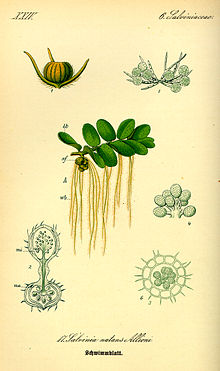Common swimming fern
| Common swimming fern | ||||||||||||
|---|---|---|---|---|---|---|---|---|---|---|---|---|

Common swimming fern ( Salvinia natans ) |
||||||||||||
| Systematics | ||||||||||||
|
||||||||||||
| Scientific name | ||||||||||||
| Salvinia natans | ||||||||||||
| ( L. ) All . |
The common swimming fern ( Salvinia natans ), also known as the common swimming fern , is an aquatic plant from the fern group and belongs to the family of the swimming fern family (Salviniaceae).
description
The species is annual and swims horizontally on the surface of the water, the root-like water leaves are under water and are free-swimming, i.e. not anchored in the ground. Stems of the plant grow to a length of 5 to 10 centimeters. The leaves are arranged in threefold whorls and differ fundamentally in structure and function ( heterophylly ):
The top two are floating leaves. They have many air chambers ( intercellular ) inside and, due to their low density, provide buoyancy. Numerous, crown-shaped plant hairs sit on the epidermis . Due to a coating with wax, these can not be wetted with water. After submerging, an air jacket is held between the stiff hair, which gives the plant additional buoyancy so that it can quickly reappear to the surface of the water.
The third leaf, the water leaf, is submerged like the shoot . It is finely divided and appears thread-like and hairy. This gives it a very large surface through which it absorbs dissolved nutrients from the water. It not only resembles a root externally , but also fulfills its function of absorbing substances from the environment. In contrast to the floating leaves, the water leaf does not contain any chlorophyll and is therefore not capable of photosynthesis .
While the floating leaves of Salvinia natans are elongated-elliptical, they are, for example, of the species group Salvinia auriculata agg. rather rounded-oval.
The chromosome number of the species is 2n = 16, 18 or approx. 30.
ecology
The common swimming fern is predominantly annual and uneven leaved, i. H. the leaves are arranged in 3-fold whorls. The top two are designed as floating leaves. The bottom, facing the water, is finely divided as a "water leaf" and divided into root-like sections. Real roots are missing. The floating blades are equipped with large air chambers on the inside and have upright, slightly curved, long hair on the upper side and are therefore water-repellent d. H. Drops of water remain as "pearls" on the hair air cushion. In this way, the stomata are protected from wetting with water which hinders gas exchange. When submerged, the hair pulls air bubbles with it, which immediately pull the leaf back to the surface of the water.
Multiplication
The reproductive conditions are quite complicated. There is different pore size or heterosporia . Groups of micro and megaspores are each enclosed in a sterile shell, the indusium , which creates fruit-like structures, the so-called sporocarpies . In megasporangium a single developed mega spore , which is surrounded by a sporangium and later with that detached from the mother plant and overwinter in the mud floor. The multicellular female prothallium grows in the megaspore and then after fertilization the embryo . In spring, new plants germinate from the megaspores, which then rise to the surface of the water. Spore ripening is from August to October.
Distribution and habitats
The species is widespread in warm summer areas of Eurasia, with emphasis in East Asia as well as in Southern and Eastern Europe. It occurs only rarely in Central Europe, for example on the Oder, the Havel and the Middle Elbe as well as in the Upper Rhine Plain from Karlsruhe to Offenbach am Main and in Bavaria. In Germany's Red List, Salvinia natans is classified as endangered. The species is absent in Austria and Switzerland. In North America it was introduced as an aquarium plant.
The common swimming fern is a warmth-loving and nutrient-needy species that is preferred in wind-protected oxbow lakes and bays. It is a Kennart the water fern Society (Spirodelo-Salvinietum), but sometimes it comes in other duckweed companies Lemnion front of the dressing.
swell
literature
- Heinz-Dieter Krausch : Color atlas of water and bank plants. Eugen Ulmer, Stuttgart 1996, ISBN 3-8001-3352-0 , p. 176.
- Peter Sitte , Elmar Weiler , Joachim W. Kadereit , Andreas Bresinsky , Christian Körner : Textbook of botany for universities . Founded by Eduard Strasburger . 35th edition. Spektrum Akademischer Verlag, Heidelberg 2002, ISBN 3-8274-1010-X .
- Siegmund Seybold : Flora of Germany and neighboring countries. A book for identifying vascular plants that grow wild and often cultivated . Founded by Otto Schmeil , Jost Fitschen . 93rd completely revised and expanded edition. Quelle & Meyer, Wiebelsheim 2006, ISBN 3-494-01413-2 .
Individual evidence
- ↑ a b Erich Oberdorfer : Plant-sociological excursion flora for Germany and neighboring areas . 8th edition. Stuttgart, Verlag Eugen Ulmer, 2001. Page 88. ISBN 3-8001-3131-5
- ↑ a b Ruprecht Düll , Herfried Kutzelnigg : Pocket dictionary of the plants of Germany and neighboring countries. The most common Central European species in portrait . 7th, corrected and enlarged edition. Quelle & Meyer, Wiebelsheim 2011, ISBN 978-3-494-01424-1 , p. 694-695 .
Web links
- Common swimming fern. In: FloraWeb.de.
- Common swimming fern . In: BiolFlor, the database of biological-ecological characteristics of the flora of Germany.
- Profile and distribution map for Bavaria . In: Botanical Information Hub of Bavaria .
- Distribution in Switzerland [1]
- Salvinia natans (L.) All. In: Info Flora , the national data and information center for Swiss flora .
- Thomas Meyer: Swimming fern data sheet with identification key and photos at Flora-de: Flora von Deutschland (old name of the website: Flowers in Swabia )



